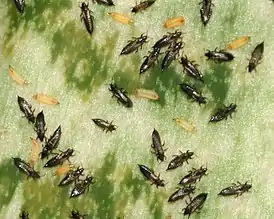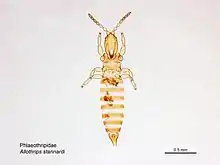Phlaeothripidae
Phlaeothripidae (лат.) — семейство крупных трипсов, единственное в составе подотряда Tubulifera. Более 400 родов и 3500 видов. Питаются грибными спорами и гифами. Idolothrips marginatus может достигать 14 мм в длину[1][2]. Среди опасных вредителей Пшеничный трипс (Haplothrips tritici)[3][4]. Самые древние находки семейства происходят из мелового ливанского янтаря[5].
Phlaeothripidae | ||||||||||||
|---|---|---|---|---|---|---|---|---|---|---|---|---|
 Suocerathrips linguis | ||||||||||||
| Научная классификация | ||||||||||||
|
||||||||||||
| Латинское название | ||||||||||||
| Phlaeothripidae Uzel, 1895 | ||||||||||||
|

Описание
Усики 8-члениковые с редукцией до 5 сегментов. От других трипсов отличаются отсутствием микрощетинок (microtrichia) на передних крыльях и трубчатым последним 10-м брюшным сегментом[1]. Некоторые представители (6 видов рода Kladothrips) проявляют элементы эусоциального поведения, сходного с муравьями и пчёлами[6][7][8]. Представители подсемейства Idolothripinae питаются спорами грибов. Среди Phlaeothripinae выделяют три эволюционные линии (Haplothrips, Liothrips и Phlaeothrips) (Mound and Marullo 1996). Линия Haplothrips в последнее время определена в качестве трибы Haplothripini (Mound and Minaei 2007, Minaei and Mound 2008), члены которой фитофаги, но некоторые виды Haplothrips хищники, питаются мелкими членистоногими. Один необычный вид Гаплотрипин хищничает, поедая яйца общественных ос (Cavalleri et al. 2013). Члены линии «Phlaeothrips lineage» микофаги, питающиеся гифами грибов (Mound et al. 2013a). Виды линии «Liothrips lineage» фитофаги, питаются на листьях кустарников и деревьев, и многие из них вызывают образование галлов на листьях (Ananthakrishnan and Raman 1989)[9]. Крупнейшие роды фитофаги (Hoplandrothrips; Holothrips; Hoplothrips; Elaphrothrips; Haplothrips; Liothrips), среди первых четырёх есть грибоядные виды[1][10].
Классификация
Выделяют 2 подсемейства: Idolothripinae (700 видов и 80 родов; питаются спорами грибов) и Phlaeothripinae (2800 видов и 370 родов)[9] 45 % родов монотипические (содержат по одному виду). Крупнейшие роды: Hoplandrothrips (105 видов); Holothrips (125); Hoplothrips (130); Elaphrothrips (140); Haplothrips (250); Liothrips (280)[1][10][11][12].
Idolothripinae
- Acallurothrips
- Actinothrips
- Aesthesiothrips
- Allidothrips
- Allopisothrips
- Allothrips
- Anactinothrips
- Anaglyptothrips
- Anallothrips
- Atractothrips
- Azeugmatothrips
- Bacillothrips
- Bactrothrips
- Bolothrips
- Campulothrips
- Carientothrips
- Celidothrips
- Ceuthothrips
- Cleistothrips
- Compsothrips
- Cryptothrips
- Cylindrothrips
- Cyphothrips
- Dermothrips
- Diaphorothrips
- Diceratothrips
- Dichaetothrips
- Dinothrips
- Diplacothrips
- Ecacleistothrips
- Egchocephalothrips
- Elaphrothrips
- Elgonima
- Emprosthiothrips
- Ethirothrips
- Faureothrips
- Gastrothrips
- Hartwigia
- Heptathrips
- Herathrips
- Holurothrips
- Hybridothrips
- Hystricothrips
- Idolothrips
- Illinothrips
- Ischyrothrips
- Lamillothrips
- Lasiothrips
- Loyolaia
- Machatothrips
- Macrothrips
- Malesiathrips
- Mecynothrips
- Megalothrips
- Megathrips
- Meiothrips
- Minaeithrips
- Neatractothrips
- Neosmerinthothrips
- Nesidiothrips
- Nesothrips
- Ophthalmothrips
- Ozothrips
- Paractinothrips
- Pelinothrips
- Peltariothrips
- Phacothrips
- Phaulothrips
- Pinaceothrips
- Polytrichothrips
- Priesneriana
- Priesneriella
- Pseudocryptothrips
- Pseudoeurhynchothrips
- Pygothrips
- Saurothrips
- Sporothrips
- Tarassothrips
- Tiarothrips
- Zactinothrips
- Zeuglothrips
- Zeugmatothrips
Phlaeothripinae
- Ablemothrips
- Acaciothrips
- Acanthothrips
- Aclystothrips
- Acrosothrips
- Adamantothrips
- Adelphothrips
- Adraneothrips
- Adrothrips
- Adurothrips
- Advenathrips
- Aeglothrips
- Aesthetothrips
- Afrothrips
- Agnostochthona
- Agrothrips
- Agynaikothrips
- Aiganothrips
- Akainothrips
- Akthethrips
- Alerothrips
- Aleurodothrips
- Alloiothrips
- Alocothrips
- Amothrips
- Amphibolothrips
- Amynothrips
- Ananthakrishnana
- Ananthakrishnanothrips
- Andrethrips
- Androthrips
- Apelaunothrips
- Apostlethrips
- Apterygothrips
- Araeothrips
- Arrhenothrips
- Asemothrips
- Asianthrips
- Ataliothrips
- Athlibothrips
- Aulothrips
- Austrothrips
- Ayyarothrips
- Azaleothrips
- Baenothrips
- Bagnalliella
- Bamboosiella
- Bebelothrips
- Biconothrips
- Blepharidothrips
- Boothrips
- Brachythrips
- Bradythrips
- Brakothrips
- Bunothrips
- Byctothrips
- Calamothrips
- Callithrips
- Carathrips
- Carcinothrips
- Carissothrips
- Carius
- Cartomothrips
- Cecidothrips
- Cephalothrips
- Cephenothrips
- Chaetokarnyia
- Chalepothrips
- Chamaeothrips
- Chelaeothrips
- Chiraplothrips
- Chiridothrips
- Chiridurothrips
- Chirothripoides
- Chlarathrips
- Choleothrips
- Chorithrips
- Chortothrips
- Chromatothrips
- Chthonothrips
- Claustrothrips
- Conocephalothrips
- Corroboreethrips
- Corycidothrips
- Coryphothrips
- Coxothrips
- Craniothrips
- Crespithrips
- Crinitothrips
- Crotonothrips
- Csirothrips
- Dactylothrips
- Deplorothrips
- Dexiothrips
- Dimorphothrips
- Diphyothrips
- Dixothrips
- Docessissophothrips
- Dolicholepta
- Dolichothrips
- Domatiathrips
- Domeothrips
- Dopothrips
- Dunatothrips
- Dyothrips
- Dyscolothrips
- Ecacanthothrips
- Eothrips
- Eparsothrips
- Epomisothrips
- Eschatothrips
- Eugynothrips
- Eumorphothrips
- Euoplothrips
- Eupathithrips
- Eurhynchothrips
- Euryaplothrips
- Eurynothrips
- Eurythrips
- Eurytrichothrips
- Gabonothrips
- Gemmathrips
- Gigantothrips
- Glaridothrips
- Glenothrips
- Glubothrips
- Gluphothrips
- Glyptothrips
- Gnophothrips
- Godoythrips
- Gomphiothrips
- Goniothrips
- Grypothrips
- Gymnothrips
- Gynaikothrips
- Habrothrips
- Hadothrips
- Halothrips
- Hansonthrips
- Hapedothrips
- Hapelothrips
- Haplothrips
- Hapsidothrips
- Heligmothrips
- Heliothripoides
- Heptadikothrips
- Hexadikothrips
- Hindsiothrips
- Holcothrips
- Holopothrips
- Holothrips
- Hoodiana
- Hoplandrothrips
- Hoplothrips
- Horistothrips
- Hyidiothrips
- Idiothrips
- Iniothrips
- Iotatubothrips
- Isotrichothrips
- Jacobothrips
- Jacotia
- Jennythrips
- Karnyothrips
- Katothrips
- Kellyia
- Kladothrips
- Kochummania
- Koptothrips
- Kolia
- Leeuwenia
- Leptoliothrips
- Leptothrips
- Lichanothrips
- Liophlaeothrips
- Liothrips
- Liotrichothrips
- Lispothrips
- Lissothrips
- Litotetothrips
- Lizalothrips
- Logadothrips
- Lonchothrips
- Lygothrips
- Macrophthalmothrips
- Majerthrips
- Malacothrips
- Mallothrips
- Manothrips
- Margaritothrips
- Mastigothrips
- Mathetithrips
- Matilethrips
- Maurithrips
- Maxillata
- Maxillithrips
- Medogothrips
- Megeugynothrips
- Membrothrips
- Menothrips
- Mesicothrips
- Mesothrips
- Metriothrips
- Microdontothrips
- Mimothrips
- Mixothrips
- Moultonides
- Murphythrips
- Mutothrips
- Mychiothrips
- Myopothrips
- Mystrothrips
- Necrothrips
- Neocecidothrips
- Neodixothrips
- Neohoodiella
- Neothrips
- Neurothrips
- Ocnothrips
- Octurothrips
- Ocythrips
- Oidanothrips
- Okajimathrips
- Opidnothrips
- Orthothrips
- Ostlingothrips
- Pachyliothrips
- Panceratothrips
- Panoplothrips
- Parabaphothrips
- Paracholeothrips
- Paramystrothrips
- Pedoeothrips
- Pegothrips
- Pentagonothrips
- Phallothrips
- Phasmothrips
- Phenicothrips
- Phenothrips
- Phiarothrips
- Philothrips
- Phlaeothrips
- Phorinothrips
- Phylladothrips
- Pistillothrips
- Plagiothrips
- Plectrothrips
- Pleurothrips
- Plicothrips
- Pnigmothrips
- Podothrips
- Poecilothrips
- Polygonothrips
- Pongola
- Ponticulothrips
- Porcothrips
- Praeciputhrips
- Praepodothrips
- Preeriella
- Priesneria
- Priesnerothrips
- Pristothrips
- Prohaplothrips
- Proleeuwenia
- Propealiothrips
- Propesolomonthrips
- Prosantothrips
- Protolispothrips
- Psalidothrips[13]
- Pselaphothrips
- Psenothrips
- Psephenothrips
- Pseudophilothrips
- Pueblothrips
- Pygmaeothrips
- Pyknothrips
- Ramakrishnaiella
- Retiothrips
- Rhaptothrips
- Rhinoceps
- Rhopalothripoides
- Rosingothrips
- Sacothrips
- Sagenothrips
- Sakimurella
- Salothrips
- Sartrithrips
- Sauridothrips
- Scelothrips
- Schazothrips
- Schedothrips
- Schlechtendalia
- Schwarzithrips
- Scopaeothrips
- Sedulothrips
- Senarioliothrips
- Senegathrips
- Senithrips
- Sinuothrips
- Smicrothrips
- Socothrips
- Solomonthrips
- Sophikothrips
- Sophiothrips
- Sphingothrips
- Spilothrips
- Stannardiana
- Stannardothrips
- Stegothrips
- Stenocephalothrips
- Stephanothrips
- Stictothrips
- Stigmothrips
- Stomothrips
- Strassenia
- Strepterothrips
- Streptothrips
- Sucinothrips
- Sumatrothrips
- Sunaitothrips
- Suocerathrips
- Symphyothrips
- Synergothrips
- Syringothrips
- Talitha
- Tamilthrips
- Temenothrips
- Terthrothrips
- Tetracanthothrips
- Tetradothrips
- Tetragonothrips
- Teuchothrips
- Thaumatothrips
- Thilakothrips
- Thlibothrips
- Thorybothrips
- Tolmetothrips
- Torvothrips
- Trachythrips
- Tragothrips
- Treherniella
- Triadothrips
- Trichinothrips
- Tropothrips
- Truncatothrips
- Trybomia
- Trypanothrips
- Tumidothrips
- Turmathrips
- Tylothrips
- Urothrips
- Veerabahuthrips
- Vicinothrips
- Vuilletia
- Walkerthrips
- Warithrips
- Williamsiella
- Xaniothrips
- Xeroleptothrips
- Xiphidothrips
- Xyelethrips
- Xylaplothrips
- Xyloplothrips
- Yarnkothrips
- Zaliothrips
- Zelotothrips
- Zemiathrips
- Zuluiella
См. также
Примечания
- OzThrips: Phlaeothripidae
- Mound L. A. 1974. Spore-feeding thrips (Phlaeothripidae) from leaf litter and dead wood in Australia. Australian Journal of Zoology Supplementary Series. Volume 22 Number 27. pp. 1-106
- Жичкина Л. Н., Каплин В. Г. Особенности биологии, экологии и вредоносности пшеничного трипса Haplothrips tritici Kurd. (Thysanoptera) в лесостепи среднего Поволжья. / Энтомол. обозр., 2001. Т. 80, Вып. 4. С. 830—842.
- Шуровенков Ю. Б. Пшеничный трипс в Зауралье и меры борьбы с ним. М.: Колос, 1971. 89 с.
- Patricia Nel, Enrique Peñalver, Dany Azar, Gilbert Hodebert, André Nel. Modern thrips families Thripidae and Phlaeothripidae in Early Cretaceous amber (Insecta: Thysanoptera) // Annales de la Société entomologique de France (N.S.). — 2010-01-01. — Т. 46, вып. 1—2. — С. 154–163. — ISSN 0037-9271. — doi:10.1080/00379271.2010.10697651.
- Chapman, T. W., B. J. Crespi, B. D. Kranz, and M. P. Schwartz. «High Relatedness and Inbreeding at the Origin of Eusociality in Gall-inducing Thrips.» Proceedings of the National Academy of Sciences 97.4 (2000): 1648—650. PNAS. 15 Feb. 2000. Web.
- Kranz B.D., M.P. Schwarz, L.A. Mound and B.J. Crespi, 1999. Social biology and sex ratios of the eusocial gall-inducing thrips Kladothrips hamiltoni. Ecol. Entomol. 24: 432—442.
- Kambiz Minaei. 2013. Thrips (Insecta, Thysanoptera) of Iran: a revised and updated checklist. ZooKeys 330: 53-74, doi: 10.3897/zookeys.330.5939
- Li-Hong Dang, Laurence A. Mound, Ge-Xia Qiao. Conspectus of the Phlaeothripinae genera from China and Southeast Asia (Thysanoptera, Phlaeothripidae) (англ.) // Zootaxa : Журнал. — Auckland, New Zealand: Magnolia Press, 2014. — Vol. 3807, no. 1. — P. 1—82. — ISSN 1175-5326. — doi:10.11646/zootaxa.3807.1.1.
- Thrips of the World Checklist (1). Subfamily Idolothripinae Bagnall, 1908
- Thrips of the World Checklist (2). Subfamily Phlaeothripinae Uzel, 1895
- Species of the fungivorous genus Psalidothrips Priesner from China, with five new species. Zookeys. Дата обращения: 3 апреля 2018.
Литература
- Mound, L. A. and A. K. Walker. 1986. Tubulifera (Insecta: Thysanoptera). Fauna of New Zealand 0(10):3-140.
- Mound L. A., Heming, B. S. & Palmer J. M. (1980). Phylogenetic relationships between the families of recent Thysanoptera. Zoological Journal of the Linnean Society of London. 69: 111—141
- Mound, L. A.; Morris, D. C. 2007: A new thrips pest of Myoporum cultivars in California, in a new genus of leaf-galling Australian Phlaeothripidae (Thysanoptera). Zootaxa, 1495: 35-45.
- Sakimura, K., 1971: A review of the genus Rhaebothrips Karny (Thysanoptera: Phlaeothripidae). Pacific Insects 13 (2): 391—403.
Ссылки
- OzThrips: Phlaeothripidae
- eol.org
- Phlaeothripidae (CSIRO). (англ.) (Дата обращения: 14 февраля 2012)